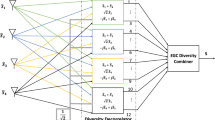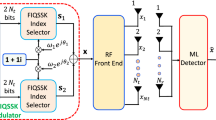Abstract
In this paper, carrier multiplexing generalized space shift keying (CM-GSSK) transmission scheme with low decoding complexity is proposed for multiple-input multiple-output (MIMO) systems, using quadrature carriers to increase the spectral efficiency. The CM-GSSK transmission scheme allows two antennas to be active during the same time slot, where the information is conveyed only by the transmit-antenna index. In CM-GSSK transmission scheme, each antenna transmits quadrature carriers, whereas conventional generalized space shift keying (GSSK) transmits the same radio frequency carrier pulse. Unlike a traditional linear decorrelator which is designed for MIMO receiver, a low complexity linear decorrelator based decoder for CM-GSSK scheme is presented and its performance is analyzed. At the receiver, the linear decorrelator decouples the received signal, which in turn, it significantly reduces the decoding complexity. The bit error rate (BER) performance results and the complexity of the proposed low complexity decoding scheme is compared with the baseline SSK schemes to demonstrate its efficiency.











Similar content being viewed by others
References
Alamouti, S. (1998). A simple transmit diversity technique for wireless communications. IEEE Journal on Selected Areas in Communications, 16(8), 1451–1458.
Anderson, T. W. (1962). An introduction to multivariate statistical analysis. New York: Wiley.
Chau, Y.A. (2001). Space modulation on wireless fading channels. In IEEE VTS 54th Vehicular Technology Conference, 2001. VTC 2001 Fall.
Dhanasekaran, S. (2016). Space-polarization shift keying modulation for mimo channels. Wireless Personal Communications, 86(3), 1509–1539.
Di Renzo, M., & Haas, H. (2010). A general framework for performance analysis of space shift keying (ssk) modulation for miso correlated nakagami-m fading channels. IEEE Transactions on Communications, 58(9), 2590–2603.
Gradshteyn, I. S., & Ryzhik, I. M. (2014). Table of integrals, series, and products. New York: Academic.
Haykin, S. (2008). Communication systems. New York: Wiley.
Jeganathan, J., Ghrayeb, A., Szczecinski, L. (2008). Generalized space shift keying modulation for mimo channels. In IEEE 19th international symposium on personal, indoor and mobile radio communications 2008, PIMRC 2008 (pp. 1–5).
Jeganathan, J., Ghrayeb, A., Szczecinski, L., & Ceron, A. (2009). Space shift keying modulation for mimo channels. IEEE Transactions on Wireless Communications, 8(7), 3692–3703.
Liang, H. W., Chang, R. Y., Chung, W. H., Zhang, H., & Kuo, S. Y. (2012). Bi-space shift keying modulation for mimo systems. IEEE Communications Letters, 16(8), 1161–1164.
Mesleh, R., Ikki, S. S., & Aggoune, H. M. (2015). Quadrature spatial modulation. IEEE Transactions on Vehicular Technology, 64(6), 2738–2742.
Mesleh, R. Y., Haas, H., Sinanovic, S., Ahn, C. W., & Yun, S. (2008). Spatial modulation. IEEE Transactions on Vehicular Technology, 57(4), 2228–2241.
Nakagami, M. (1960). The m-distribution-a general formula of intensity distribution of rapid fading. In W. G. Hoffman (Ed.), Statistical method of radio propagation. Oxford: Pergamon Press.
Simon, M. K., & Alouini, M. S. (2005). Digital communication over fading channels (Vol. 95). New York: Wiley.
Tarokh, V., Jafarkhani, H., & Calderbank, A. R. (1999). Space–time block codes from orthogonal designs. IEEE Transactions on Information Theory, 45(5), 1456–1467.
Tse, D., & Viswanath, P. (2005). Fundamentals of wireless communication. Cambridge: Cambridge University Press.
Wang, J., Jia, S., & Song, J. (2012). Generalised spatial modulation system with multiple active transmit antennas and low complexity detection scheme. IEEE Transactions on Wireless Communications, 11(4), 1605–1615.
Wolniansky, P.W., Foschini, G.J., Golden, G., & Valenzuela, R. (1998). V-blast: An architecture for realizing very high data rates over the rich-scattering wireless channel. In 1998 URSI international symposium on signals, systems, and electronics 1998, ISSSE 98 (pp. 295–300).
Author information
Authors and Affiliations
Corresponding author
Rights and permissions
About this article
Cite this article
Dhanasekaran, S. Carrier Multiplexing Generalized Space Shift Keying Modulation with Low Decoding Complexity. Wireless Pers Commun 97, 365–385 (2017). https://doi.org/10.1007/s11277-017-4509-4
Published:
Issue Date:
DOI: https://doi.org/10.1007/s11277-017-4509-4




